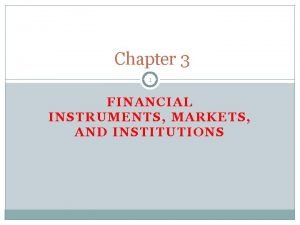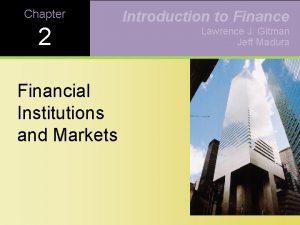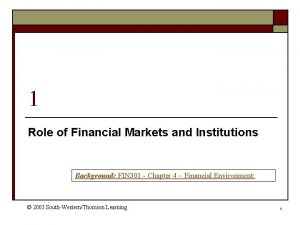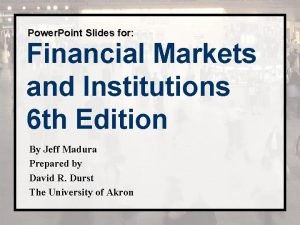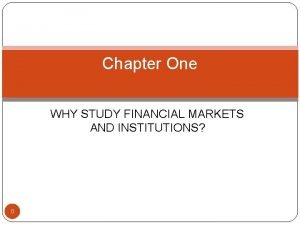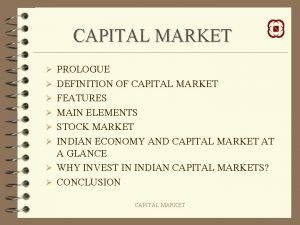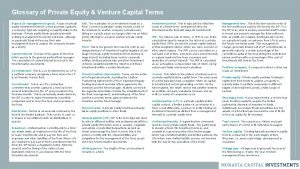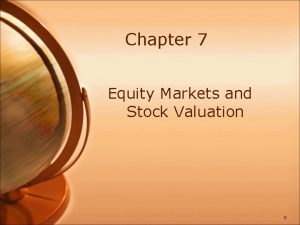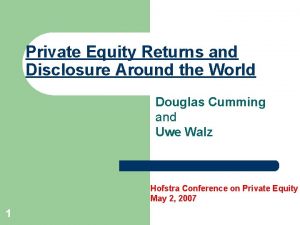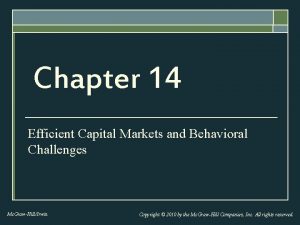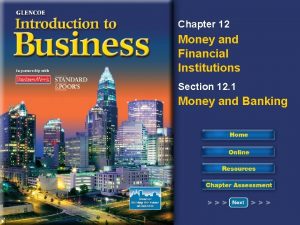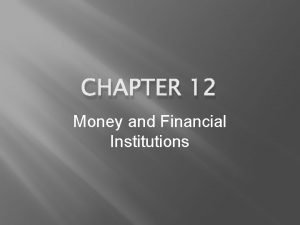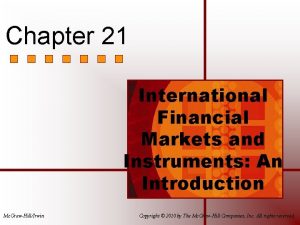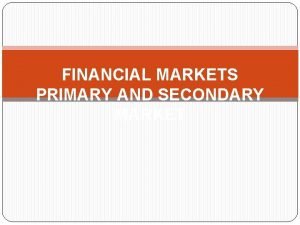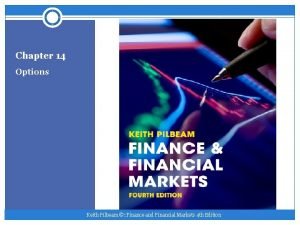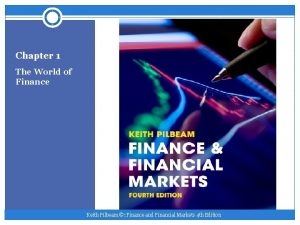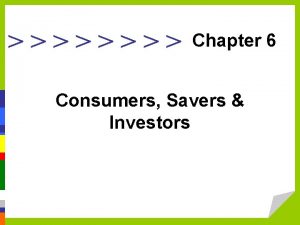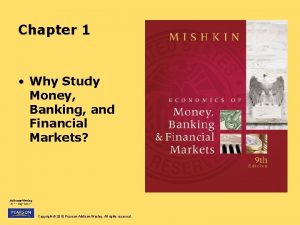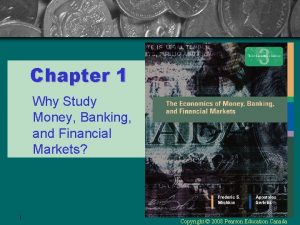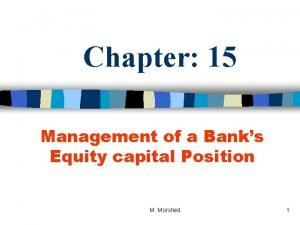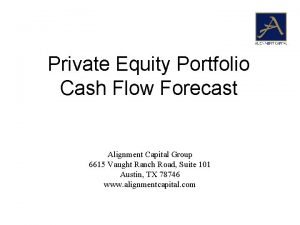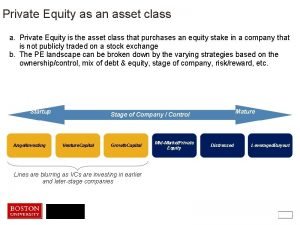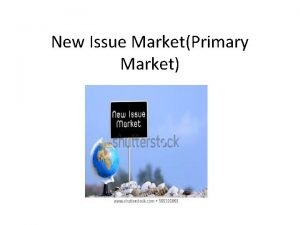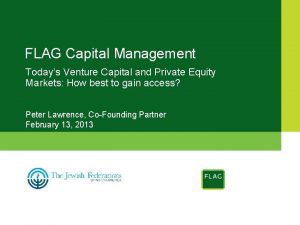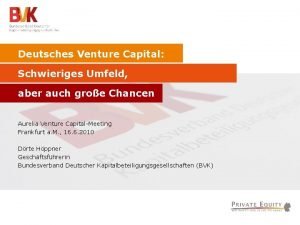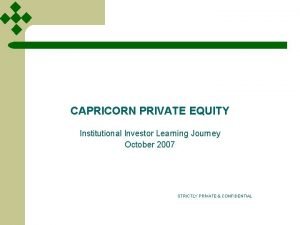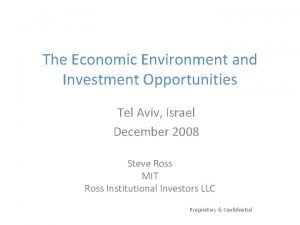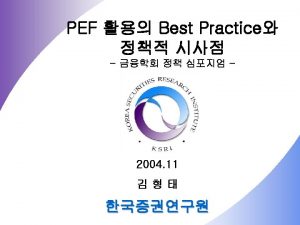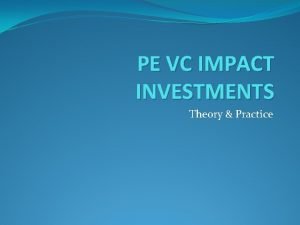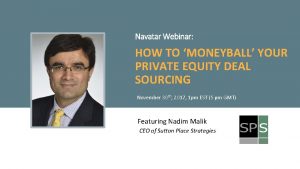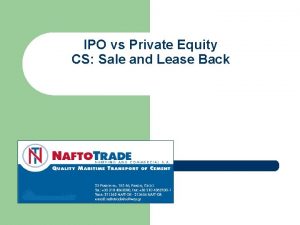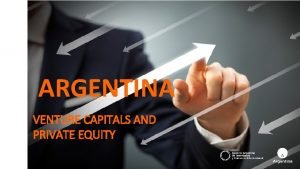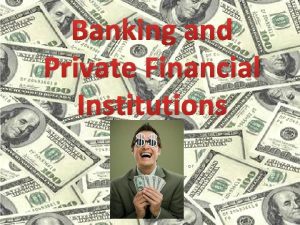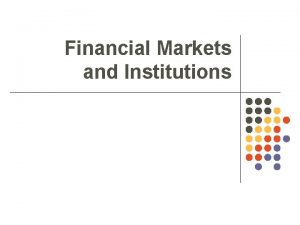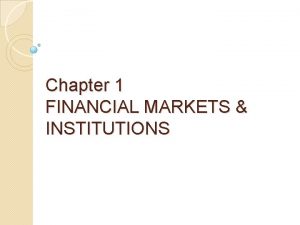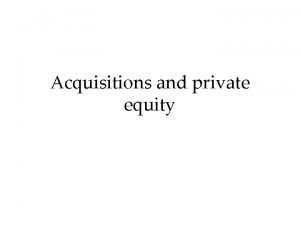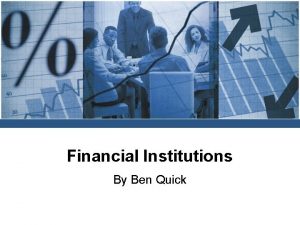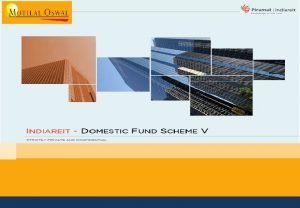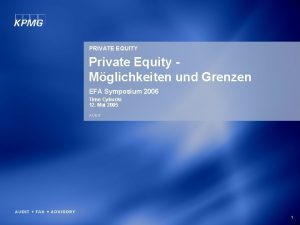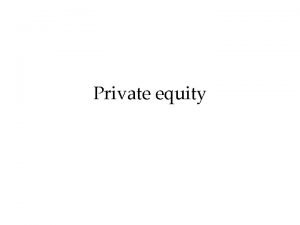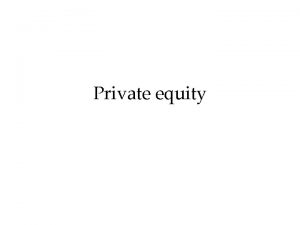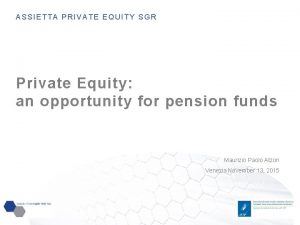PRIVATE EQUITY CAPITAL MARKETS AND FINANCIAL INSTITUTIONS NGLZCE















































- Slides: 47

PRIVATE EQUITY CAPITAL MARKETS AND FINANCIAL INSTITUTIONS İNGİLİZCE İŞLETME DOKTORA PROGRAMI ALAATTIN YOLAÇTI

PRESENTATION LAYOUT 1 2 3 4 PRIVATE EQUITY – OVERVIEW PRIVATE EQUITY FUNDS KEY ISSUES IN PRIVATE EQUITY APPLICATIONS PRIVATE EQUITY MARKET

1 PRIVATE EQUITY - OVERVIEW

WHAT IS PRIVATE EQUITY (PE)? § Financing is a critical key succes of a business § Private Equity (hence on PE) is alternative method to that may meet the needs of entrepreneurs § PE is the provision of equity capital by financial investors over the medium or long term on companies with high growth potential § Equity owner can join in management of the business or can join by information sharing due to reasons ; • investor • The investor may want to have a control over the company to lower risk

WHAT IS PRIVATE EQUITY (PE)? -2 The system briefly works as follows ; ü Equity owner supplies capital to entrepreneur in return for stocks of project by participating risks of projects in opposition to other financial associations ü After 5 -10 years when the stocks come into value at the market , equity owner sells them and gains revenue from this investment. ü The expected profit rate for the investor is annually %18 -%35 or more in developing markets

WHAT IS PRIVATE EQUITY (PE)? -3 q PE is largely applied to the companies whose investments arenot quoted to the capital market q It is classified under the title of “ alternative investments” q PE is high-risk high profit class as well as an alternative finance type for the small and medium sized enterprises q PE can also used for buyouts where investor take the controlof the company , reconstruct it and finally sell it to a strategic buyer or offer it to public BUYOUT : The purchase of the entire holdings or interests of an owner or investor.

PRIVATE EQUITY VS. LISTED EQUITY PRIVATE EQUITY LISTED EQUITY Ø LOW LIQUIDITY Ø STRONG LIQUIDITY Ø LONG HORIZON Ø SHORT OR LONG TERM INVESTMENT Ø HIGH ACTIVE INVOLMENT Ø LITTLE INVOLVEMENT Ø LOW EFFECIENCY ØHIGHER EFFECIENCY MARKET ACTIVE MARKET Ø NO PUBLISHED INFORMATION ØLOW REGULATORY OVERSIGHT Ø HIGHLY REGULATED

WHY DO COMPANIES SEEK PE? Private Equity is an alternative option for a company on similiar cases listed as follows ; ü ü ü Create a business Improve and develop the export performance Recruit highly qualified personnel Sell part or all of the company Change the size of the business and take one over competition ü Launch a new product ü Improve the management capacity ü Liquidise some of the assets

WHAT IS A PE FIRM LOOKING FOR? ü High growth, competitive products or services ü In the case of disposal or transfer, a loan capacity and recurring profits ü A quality and stable management team, capable of turning the negotiated goals into reality ü A solid management procedures either already in place or able to to be put in place ü A transparent legal structure where personal and professionnal assets are not entangled ü An agreement on the investor’s exit with or with out the head of company

CONS & PROS CONS Ø High Revenues PROS ØExcessive levels of debt to acquire corporatipns Ø Long term investment (minimum 3 years) Ø Investors rights to exit is restricted within the period Ø High liqudity risk Ø High Revenues Ø Increases portfolio variety Ø Able to reach the information of the enterprise legally. (Insider trading is not legal in the stock trading is not legal in the Stock Exchange market) Exchange Market) Ømore secure to external economic fluctations than that ØMore secure to external stock exchange market economic fluctations than that Stock Exchange Market

PRIVATE EQUITY VS. VENTURE CAPITAL-2 Definition of PE by NVCA (Natioanal Private Equity Assosication ) : Venture Capital is the capital provided by investing professionals who have the potential to be a significant participant Definition by SPK (Turkish Capital Markets Board): Venture Capital is a form of investment which enables dynamic and creative entrepreneurs who don’t have adequate financial power to fullfil their investment ideas. q THE PHILOSPHY IS SIMILIAR IN NATURE q VENTURE CAPITAL IS THE SUB-BRANCH OF PRIVATE EQUITY BESIDES INVESTING IN EARLY STAGES

PRIVATE EQUITY VS. VENTURE CAPITAL Venture capital and private equity terms are largely used as a substitute for one another but has slight differences VENTURE CAPITAL PRIVATE EQUITY v Venture capital investors invest companies at earlier stages v Provide an initial capital to an idea or 1 -3 years old companies. (Deloitte, 2007) v Includes the financial support in early stages v. It has a particular emphasis on on entrepreneural undertakings rather than nature of the business. v Investors of private equity generally donot invest on idea or premature company vrequire a background of 3 -10 years including operations. v. Private equity not only includes the financial support in early stages but also in the expansion stages v. More emphasis on business itself

STAGES OF A COMPANY DEVELOPMENT SEED : Seed financing is designed to research, asses, an develop an idea before a company has reached start up phase. Investors are mainly business angels. START UP : Start up financing is used for product development and initial marketing phase. Capital is mainly required for R&D of the product and train personnel. (Especially for electronics, life sciences sectors. ) POST CREATION : Business has already developed its product and needs capital to begin manufacturing and sell it. Yet no profit has been created EXPANSION DEVELOPMENT : Business has approached or near break even point. High growth period, capital is used to increase capacity and sales power TRANSFER/SUCCESSION : The total or partial retirement of the head of a company is often an opportunity to implement a leveraged operation.

EXPECTED RETURN VS RISK DIAGRAM

2 PE INVESTMENTS & FUNDS

PE INVESTMENT METHODS-1 I. • • II. • • DIRECT INVESTMENT : The investor himself finds the company to invest Analysis, invests and terminates it when it is time. High revenue but has a risk of loosing invested capital Only suitable for experts in PE / Less used way IN HOUSE PE FUND INVESTMENT : Investors invest their extra funds to a PE investment fund Proffesionals in this fund are experts in finding enterprises which will be invested in • Analysis, investments , management and time to quit the investment are done by these professionals III. INVESTING IN FUNDS OF FUNDS : • A fund manager evaluates various private equity funds and chooses among them and distributes the selected funds • Investors have to pay extra expenses to the manager as a consultancy service fee

PE INVESTMENT METHODS-2 TYPES OF PE INVESTMENTS Source : M. Yardım, Private Equity as an alternative financial method that support Entrepreneurship: Turkey mcıoğlu, N. Demirel, 2008, “Case”, KMU İİBF Dergisi Yıl: 10 Sayı 14 Haziran/2008

HOW DO PE FUNDS WORK? Source : Guide on Private Equity and Venture Capital for Enterpreneurs, European Venture Capital Assosiation Publications, November 2007

LIFECYCLE OF PE FUND : UNDERWRITINGS-1 1. CREATION OF A FUND AND UNDERWRITING BY PROFFESSIONAL INVESTORS : • PE management companies (General partners) after obtaining the agreement of controlling authorities establish investment funds that collect capital from investors known as Limited partners • This capital is used to buy high potential companies known as the portfolio or investee companies • PE fund managers invite the institutional investors to subscribe an investment fund for a period (usually 10 years) • The fund raising period lasts for 6 months to one year

LIFECYCLE OF PE FUND : UNDERWRITINGS-1 q Usually institutional investors cannot leave the funs before their terms completed q. Investors get prenegotiated stake in the equity of the investment and they become fully fledged shared holders, sharing the risks q. The investors aim usually is not to take the control of the company (there are exceptions) but to help create value to realise a capital gain.

LIFECYCLE OF PE FUND : INVESTING 2. INVESTING THE FUND : • Once the target amount of capital has been raised, the subscription is closed • In some cases (in Europe %30) PE funds come together to form a “financial syndicate” to make an investment in case of large size capital needs and high risk. • One of the investment company represents the group in the syndicate dealing with the enterpreneur • The private equity team usually makes the investments in the first five years of the fund

LIFECYCLE OF PE FUND : MANAGING 3. MANAGING THE INVESTMENT • The fund manager on behalf of the investors is concerned with creating value in the company, • He will follow the investment over long time period and prepare exit conditions.

LIFECYCLE OF PE FUND : EXIT 4. REDISTRIBUTION : • When the fund manager decides to exit their investment, the capital recovered from the exit is redistributed to the original investors on a pro-rata basis depending on their initial investment EXIT ROUTES : Ø Trade Sales (Merger & Acquisition trade sales, more common way) ØEnterpreneur or management team repurchase Ø Sale of the investment to another financial purchaser (Secondary Market Investor) Ø IPO (Initial public offering) : Flotation on a public stock market ØLiquidation

TYPES OF PE FUNDS CAN BE CLASSIFIED ACCORDING TO THE SHAREHOLDER PERCENTAGES AS FOLLOWS INDEPENDENT FUNDS : funds which the third parties are the main source of capital and in which no one shareholder holds a majority stake. An independent fund is the most common type. CAPTIVE PE FUNDS : Funds which one shareholder contributes the most of the capital. SEMI CAPTIVE FUNDS : Funds in which again the large part of the company belongs to one share holder, but a significant share of the capital is raised from third parties.

3 KEY ISSUES IN PE APPLICATIONS

PROCESS CHART

BUSINESS PLAN • The process of attracting a private equity company starts with a Business Plan • It is the main tool used by financial investor to evaluate business CONTENTS OF BUSINESS PLAN : üExecutive Summary ü Company History ü Managemet Team ü Products & Services ü Analysis of the market & competitors ü Commercialisation üOperational management üFinancial Projections ü Capital Required üExit Possibilities

DUE DILLIGENCE §Avabiality of the market §Management quality §Geographical situation §Proximity to the market §Financial Force §SWOT analysis §Effeciency of the Project owner §Advantage over rivals §Sharing of stocks §Patent rights §Legal infrastructure

§ COMPANY VALUATION § Valuation between PE Firm and the target company should be covered in the agreement § No pure quantitative methods, usually based on hypothesis that may be subjective § Diffucult to apply especially for start up companies GENERAL METHODS USED IN VALUATION 1. Discounted Cash Flow - If company has already has a positive cash flow 2. Comparative Methods – Using similiar price/earning ratios for a similiar company, have wide application areas 3. Opportunity Cost - Opportunity Costs of the investors if they invest in different tools

WHAT DO THE PE FUND MANAGERS DO? Fund Managers have four principal roles : 1. 2. 3. 4. Fund Raising : Funds are raised from international investments, many of which are pension funds, banks, insurance companies and high networth individuals. The investments are usually as limited partnership. Sourcing investments: A PE found must source and complete succesful transactions to generate profit. Active Management of Investments : PE managers have become hands-on managers of their investments. They don’t involve day to day control, instead actively involved in setting and implementation of the strategy. Releasing Capital Gains : The academic evidence shows that there is a wide variation in the length of time of the PE investment.

HOW ARE PE FUND MANAGERS REWARDED? üSALARY ü FEE INCOME : § Receive management fees that are expressed as a percentage of the funds raised. § Larger the funds greater the income although 3 % in smaller funds, 1 -1. 5% in larger funds for operating costs (sometimes cause principal agent problems between fund management and investors) üCARRIED INTERESTS : § Share in the profits of the fund known as carried interest § Once the investors have achieved the a certain pre-agreed rate of return (hurdle rate) , the fund managers shared in the excess (usually the %20 of the excess amount) § The hurdle rate is around %8 per annum

HOW ARE PE FUND MANAGERS REWARDED? -2

HOW IS PE COMPANY’S SUCCES MEASURED?

SUCCESS

PRIVATE EQUITY MARKET IN THE WORLD AND IN TURKEY 4

PE APPLICATIONS IN THE WORLD ØPE has been a major driving force in technological advance in the USA, Japan, Germany, Canada and England Ø Historically Digital company was the first one constructed with venture capital. Ø Constructed with 70, 000 $ and in five years time reached a value of 3, 5 billion $ sold to Compaq for 10 billion $ in 1998 ØPE houses announced more than 2, 000 deals globally worth a total of over $236 billion in 2010

PE FUNDS RAISING 2005 -2010

PE ACQUISITIONS BY REGIONS

PE ACQUISITIONS BY SECTORS IN 2010

PE APPLICATIONS IN TURKEY ØIn Turkey, financial system mostly depends on banking sector ØEspecially the SME (KOBİ) cannot benefit from traditionally recognised banking system adequately due to Mc Millan Gap Ø According to a survey made by ITO and piar among 4671 small enterprises %78 of their capital is provided by themselves, only %7 by short time banking credits ØFirst legal regulations are made by CMB (SPK), after that the first found was constructed by Vakıf Risk Capital established in 1996 MC MILLAN GAP : The name for the research which succeded in detecting the fact that traditional banking system is largely divirted to large well known corporations therefore hindering SMEs

PE INVESTMENTS IN TURKEY (BETWEEN 1996 -2007) – CONT. YEAR BUYER TARGET COMPANY SECTOR OWNERSHIP ESTIMATED INVESTMENT AMOUNT (million USD ) 1995 Nomura (Sparx Group) 1995 Vakıf Risk 1996 Nomura (Sparx Group) 1997 Nomura (Sparx Group) 1998 Merrill Lynch Investment Ünal Tarım Arat Tekstil Teknoplasma Eka Elektronik Aba Ambalaj Rant Leasing GSD Holding Biomar Termoteknik Food Textile Production Elektronics Packaging Leasing Textile Biotech Radiator Panel Producer Minority Minority Minority 2 2 1 2 6 2 8 1 5 1998 FMO 1999 Vakıf Risk 1999 Merrill Lynch Investment 1999 Citicorp Inv. Services 1999 Safron Advisors Ltd. 2000 Commercial Capital 2000 Safron Advisors Ltd. 2000 AIG Blue Voyage Fund 2000 Vakıf Risk 2000 EFG Hermes Group 2000 Taurus/Bank of America Tüyap Innova Biotechnology BIM Merko Alfa Menkul Işıklar Ambalaj Net One Galatasaray Sportif AFM Ortadoğu Yazılım Probil Gorbon Işıl BIM Arts&Entertainment Medical Retail Food Brokerage Houes Packaging ISP Soccer Marketing Arts&Entertainment Internet, ISP System Integrator Tablewear Retail Minority Minority Minority 7 2 15 2 5 10 4 21 7 1 21 1 19

PE INVESTMENTS IN TURKEY (BETWEEN 1996 -2007) – CONT. YEAR BUYER TARGET COMPANY SECTOR OWNERSHIP ESTIMATED INVESTMENT AMOUNT (million USD ) 2002İş Risk Sermayesi 2003 Soros Investment 2003İş Risk Sermayesi 2003 Turkven Private Equity/Advent 2003İş Risk Sermayesi 2004 MT Invest 2005İş Risk Sermayesi & FMO 2005 Turkven Private Equity/Pound Capital 2005 The International Investors KCSC 2005 Turkven Private Equity 2006 Providence Equity Partners 2006 Texas Pasific Group Probil Nevotek Unikom Gıda Mars Sinema UNO System Integrator IT Food Arts&Entertainment Food Minority Minority 6 3 13 5 13 ITD Step Halıcılık Karyateks Tüyap Trendtech and Retomedia Docar Filo Kiralama IT Furniture Textile Arts&Entertainment IT Minority Minority 4 3 1 36 25 Real Estate & Leasing Minority 29 Intercity Digiturk Mey İçki 15 150 810 2006 Partners in Life sciences & Citigroup 2006 Turkven & Advent International Group 2006 AIG Capital 2006 Global Finance, IDB, Goldman Sachs 2006 Turkven and FMO 2006 Bancroft PE Biofarma İlaç Real Estate & Leasing Minority Broadcasting Minority Tobacco Product Majority Man. Pharmaceyticals Majority Roma Plastics Majority 76 For you TAV Retail Airport Operations Minority 25 650 Pronet Güvenlik Standart Profil Automative 50 -50 Majority 10 90 240

PE INVESTMENTS IN TURKEY (BETWEEN 1996 -2007) – CONT. YEAR BUYER TARGET COMPANY SECTOR OWNERSHIP 2006 İş risk Sermayesi Beyaz Oto Kirlama Rental 10 2006 Ottoman Fund riva (GS) Real Estate & Leasing 110 2006 GEM Global equities Deva Holding Pharmaceuticals Majority 162 2007 Citicorp Inv. Services Boyner Retail Minority 46 2007 Citicorp Inv. Services Beymen Retail 50 -50 143 2007 İş Risk Sermayesi Ode Yalıtım Mineral Products Minority 2007 National Bank of. Kuwait Yudum Oil ESTIMATED INVESTMENT AMOUNT (million USD ) Majority Source: Resource: Deloitte, “Private Equity in Turkey – A Practical Guide for Turkish Companies and Investors”, 2007, pp. 16 -17. 5 unknown

PE INVESTMENTS IN TURKEY (BETWEEN 1996 -2007) – CONT.

CONCLUDING REMARKS q Researches show that the countries that have high entrepreneurial activities had provided a growth above avarages q KOBI’s which are supposed to vitalize economy and Industry life has to work out alternative financial methods q Private Equity Applications should be improved to support entrepreneurship in Turkey

THANK YOU FOR YOUR ATTENTION

REFERANCES 1. 2. 3. 4. 5. M. Yardımcıoğlu, N. Demirel, 2008, Private Equity as an alternative financial method that support Entrepreneurship: Turkey “Case”, KMU İİBF Dergisi Yıl: 10 Sayı 14 Haziran/2008 Akkaya G. C. , İçerli, M. Y. , 2001, “Kobilerin Finansman çözümünde risk sermayesi finansman modeli”, Dokuz Eylül Üniversitesi Sosyal Bilimler Dergisi, Cilt 3, Sayı 3, 2001 Guide on Private Equity and Venture Capital for Enterpreneurs, European venture capital Assosiation Publications, November 2007 Private Equity Demistified, An Explanatory Guide, J. Gillian, M. Wright, 2 nd edition, Corporate Finance Faculty Publications Global Private Equity Watch, Ernst Young Yearly Report, 2011
 Why study financial markets
Why study financial markets Money market participants
Money market participants Financial intermediaries ppt
Financial intermediaries ppt Basic flow of funds through the financial system
Basic flow of funds through the financial system Madura j. financial markets and institutions
Madura j. financial markets and institutions Primary vs secondary financial markets
Primary vs secondary financial markets Madura j financial markets and institutions
Madura j financial markets and institutions Why study financial markets and institutions
Why study financial markets and institutions She has a bath every evening
She has a bath every evening Equity capital markets definition
Equity capital markets definition Difference between private equity and venture capital
Difference between private equity and venture capital Savers and investors role in financial markets
Savers and investors role in financial markets Financial markets and the allocation of capital
Financial markets and the allocation of capital Equity markets and stock valuation
Equity markets and stock valuation Private equity returns and disclosure around the world
Private equity returns and disclosure around the world Efficient capital markets and behavioral challenges
Efficient capital markets and behavioral challenges Chapter 12 money and financial institutions
Chapter 12 money and financial institutions Chapter 12 money and financial institutions
Chapter 12 money and financial institutions Private markets usually fail to provide lighthouses because
Private markets usually fail to provide lighthouses because What is financial intermediation
What is financial intermediation International financial markets and instruments
International financial markets and instruments Methods of floatation in primary market
Methods of floatation in primary market Foreign exchange and international financial markets
Foreign exchange and international financial markets Pilbeam k. finance and financial markets
Pilbeam k. finance and financial markets Pilbeam finance and financial markets
Pilbeam finance and financial markets Savers and investors role in financial markets
Savers and investors role in financial markets Why study money banking and financial markets
Why study money banking and financial markets Why study money banking and financial markets
Why study money banking and financial markets Chapter 15 debt and equity capital
Chapter 15 debt and equity capital Jasper private equity
Jasper private equity Private equity cash flow forecasting
Private equity cash flow forecasting National venture capital association yearbook
National venture capital association yearbook What is meant by new issue market
What is meant by new issue market Lbo model case study
Lbo model case study Flag private equity
Flag private equity Aurelia private equity
Aurelia private equity Private equity career
Private equity career Aavin private equity
Aavin private equity Geoff snelgar net worth
Geoff snelgar net worth Hccg private equity
Hccg private equity Private equity
Private equity Private equity
Private equity Private equity market
Private equity market Moic irr
Moic irr Navatar private equity
Navatar private equity Private equity vs ipo
Private equity vs ipo Private equity argentina
Private equity argentina Thomson
Thomson



